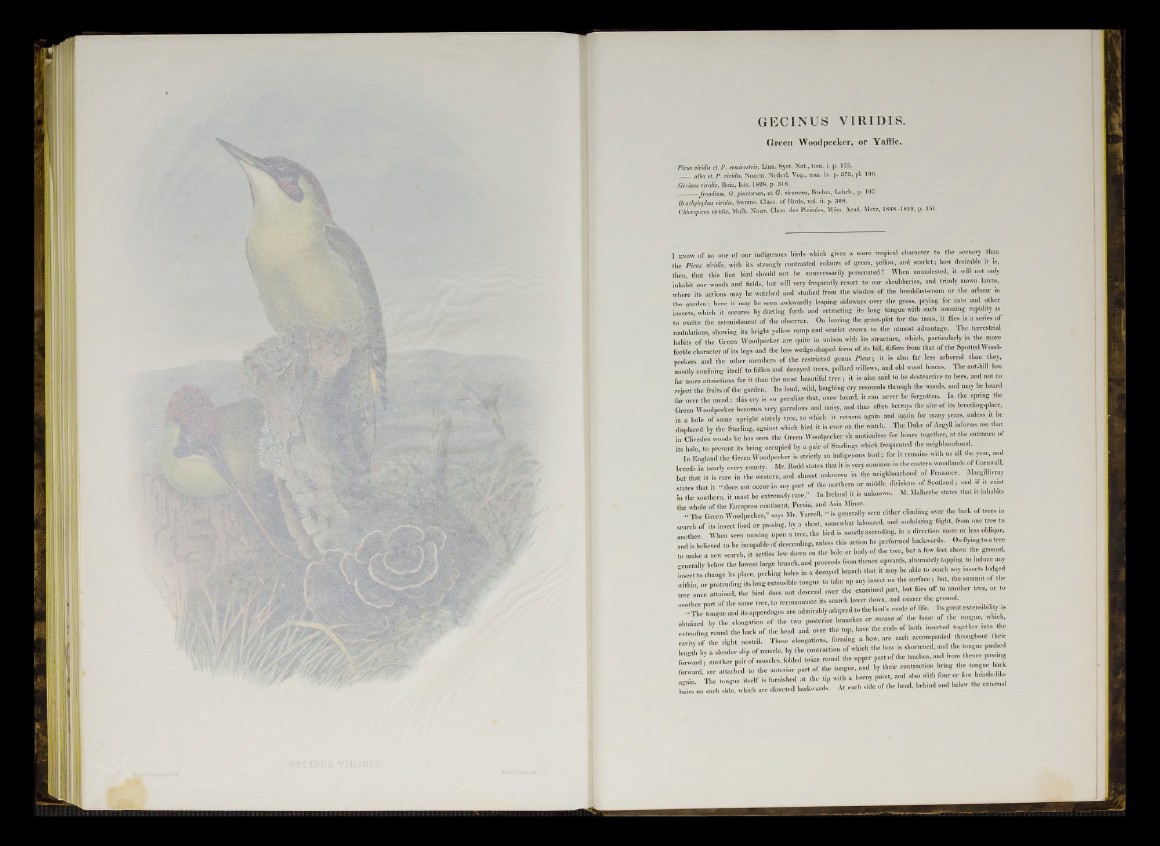
GEC1NUS VIRIDIS.
Green Woodpecker, or Yaffle.
Picvs viridis et P. semirostris, Linn. Syst. Nat., tom. i. p. 175.
alba et P. viridis, Nozem. Nederl. Vog., tom. iv. p. 373, pi. 190.
Gecinus viridis, Boie, Isis, 1828, p. 316.
frvtidium, G. pinetmm, et G. virescens, Brehm, Lehrb., p. 197.
Brachylopkus viridis, Swains. Class, of Birds, vol. ii. p. 308..
Ghloropicus viridis, Malh. Nouv. Class, des PicinSes, Mem. Acad. Metz, 1848-1849, p. 351.
KNOW of no one of our indigenous birds which gives a more tropical character to the scenery than
he Pirns viridis, with its strongly contrasted colours of green, yellow, and scarlet-, how desirable it is,
hen, that this fine bird should not be unnecessarily persecuted 1 When unmolested, it will not only
nhahit our woods and fields, but will very frequently resort to our shrubberies, and trimly mown lawns,
vhere its actions may be watched and studied from the window of the brcakfast-room or the arhour in
he garden ; here it may be seen awkwardly leaping sideways over the grass, prying for ants and other
nsects which it secures by darting forth and retracting its long tongue with such amazing rapidity as
o excite the astonishment o f the observer. On leaving the grass-plat for the trees, it flies in a series of
indulations, showing its bright yellow rump and scarlet crown to the utmost advantage. 'Hie terrestrial
mbits of the Green Woodpecker are quite in unison with its structure, which, parttcularly tn the more
eeble character of its legs and the less wedge-shaped form of its bill, differs from that of the Spotted Woodpeckers
and the other members of the restricted genus Ficus -, it is also far less arboreal than they,
mostly confining itself to fallen and decayed trees, pollard willows, and old wood fences. The an thill has
far more attractions for it than the most beautiful t r e e ; it is also said to be destructive to bees, and not to
reiect the fruits of the garden. Its loud, wild, laughing cry resounds through the woods, and may be heard
far over the mead: this cry is so peculiar that, once heard, it can never he forgotten. In the spring the
Green Woodpecker becomes very garrulous and noisy, and thus often betrays the site of its breeding-place,
in a hole of some upright stately tree, to which it returns again and again for many years unless it be
displaced by the Starling, against which bird it is ever on the watch. The Duke of Argyll informs me that
in Cliveden woods he has seen the Green Woodpecker sit motionless for hours together, at the entrance of
its hole, to prevent its being oecnpied by a pair of Starlings which frequented the neighbourhood.
In England the Green Woodpecker is strictly an indigenous b ird ; for it remains with us al the year, and
breeds in nearly every comity. Mr. Kodd states that it is very common in the eastern woodlands of Cornwall,
but that it is rare in the western, and almost unknown in the neighbourhood of Penzance. —
states that it 1 does not occur in any p art of the northern or middle divisions of Scotland.; and if it exist
in the southern, it must be extremely rare.” In Ireland it is unknown. M. Malherbe states that it inhabits
the whole of the European continent, Persia, and Asia Minor. H B B B !
The Green Woodpecker,” says Mr. Yarrell, “ is generally seen either climbing over the bark of trees in
search o f its insect food or passing, by a short, somewhat laboured, and undulating flight, from one tree to
another. When seen moving upon a tree, the bird is mostly ascending, in a direction more or less oblique,
and is believed to be incapable of descending, unless this action be performed backwards. On flyung to a tree
to make a new search, it settles low down on the bole or body of the tree, but a few feet above the ground,
generally below the lowest large branch, and proceeds from thence upwards, alternately tapping to induce any
L e c t to change its place, pecking holes in a decayed branch that it may be able to reach any insects lodged
within, or protruding its long extensible tongue to take up any insect on the surface;; but, the summit of the
tree once attained, the bird does not descend over the examined part but fl.es off to another tree, or
another part of the same tree, to recommence its search lower down, and nearer the ground,
■The tongue and its appendages are admirably adapted to the bird's mode of life, t o great; extensibility is
obtained by the elongation of the two posterior branches or cornua of the bone o f the tongue, which,
extending round the back of the head and over the top, have the ends of both inserted together into the
cavity of the right nostril. These elongations, forming a bow, are each accompanied throughout their
length by a slender slip o f muscle, by the contraction of which the bow is shortened, and the tongue pushed
l a r d - another pair o f muscles, folded twice round the upper par, of the trachea, and from thence passing
rward, are attached to the anterior part of the tongue, and by their contraction bnng he ongne b ek
2 - flir„Uhed at the tin with a homy point, and also with four or five bristle-like T lin Innmiff i t s e l f I